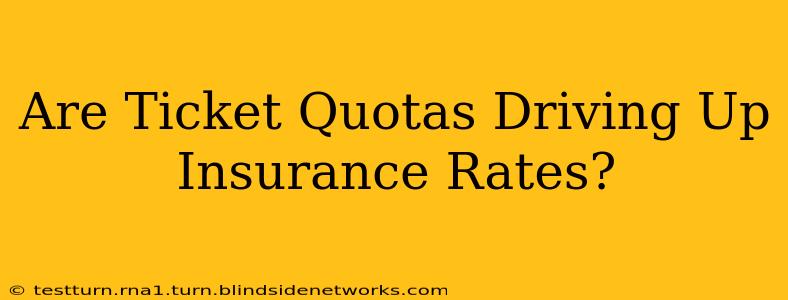Are Ticket Quotas Driving Up Insurance Rates? A Deep Dive into the Complex Relationship
The rising cost of car insurance is a concern for many, and it's natural to wonder if seemingly unrelated factors, like ticket quotas for police officers, are playing a role. While there's no direct, causal link between ticket quotas and insurance rates, the relationship is more nuanced and deserves a closer look. Let's unravel this complex issue.
Imagine this: You're driving down the road, minding your own business, when suddenly, blue and red lights flash in your rearview mirror. A speeding ticket, perhaps, or maybe something more serious. This seemingly isolated incident can have ripple effects, impacting not only your wallet immediately but potentially your insurance rates for years to come. But what if the officer issuing that ticket was under pressure to meet a quota? Could this pressure influence their decisions, leading to more tickets and, consequently, higher insurance premiums for everyone?
This question has sparked considerable debate. Let's explore the key aspects:
Do Ticket Quotas Exist, and How Do They Work?
Many jurisdictions deny the existence of formal ticket quotas. However, the concept of implicit pressure on officers to generate a certain number of citations exists in many places. This pressure might be subtle, stemming from performance evaluations, departmental goals, or even a general sense of community expectation to "crack down" on traffic violations. The pressure isn't always explicitly stated as a quota, but the underlying expectation can influence officer behavior.
How Do More Tickets Affect Insurance Rates?
The impact of increased tickets on insurance rates is straightforward: more tickets translate to a higher risk profile for insurance companies. Insurance is fundamentally about assessing risk. Drivers with a history of violations are considered higher risk, leading to higher premiums. The more tickets issued, regardless of whether quotas are officially in place, leads to a larger pool of high-risk drivers, influencing the overall cost of insurance for everyone.
Could Implicit Pressure Influence Ticket Issuance?
The crux of the matter lies here. While formal quotas are often denied, the existence of performance metrics and community pressure can implicitly encourage officers to issue more tickets. This isn't about individual officers maliciously targeting drivers; it's about the systemic pressure that shapes their behavior. This pressure could lead to more tickets being issued, even for minor infractions that might otherwise be overlooked.
What Other Factors Contribute to Rising Insurance Rates?
It's crucial to understand that numerous other factors influence insurance costs. These include:
- Increased repair costs: Modern vehicles are increasingly complex and expensive to repair.
- Rising medical costs: Treatment for injuries sustained in accidents drives up insurance payouts.
- Claims frequency: A higher number of accidents in a region will impact rates for everyone in that area.
- Inflation: The general rise in prices affects all aspects of the insurance industry.
- Administrative costs: The cost of running insurance companies contributes to premiums.
Is There a Direct Correlation Between Quotas and Insurance Costs?
While a direct causal link is hard to definitively prove, the indirect relationship is undeniable. More tickets issued (potentially influenced by implicit pressure) lead to a larger pool of higher-risk drivers, increasing the overall cost of insurance. It's a complex interplay of factors, and isolating the effect of ticket quotas alone is challenging.
Conclusion: A Complex Issue with No Simple Answers
The question of whether ticket quotas directly drive up insurance rates is not a simple yes or no. While no formal quota system directly dictates insurance premiums, the existence of implicit pressures on police officers can lead to increased ticket issuance. This, in turn, contributes to a higher pool of high-risk drivers, impacting the overall cost of insurance. It's a complex web of interconnected factors, requiring a nuanced understanding of the interplay between law enforcement practices, insurance risk assessment, and economic forces. Further research into the impact of implicit pressure on police behavior and its consequences for the insurance industry is warranted.

